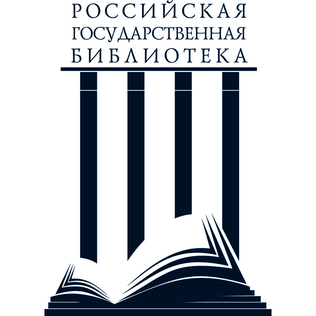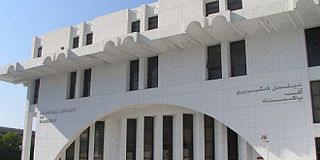| State Library of Turkmenistan | |
|---|---|
| Döwlet kitaphanasy | |
 | |
| Country | |
| Type | National library |
| Established | 1895 |
| Location | Ashgabat |
| Collection | |
| Items collected | 5 530 000 |
The State Library of Turkmenistan is located in Ashgabat, Turkmenistan. [1]
| State Library of Turkmenistan | |
|---|---|
| Döwlet kitaphanasy | |
 | |
| Country | |
| Type | National library |
| Established | 1895 |
| Location | Ashgabat |
| Collection | |
| Items collected | 5 530 000 |
The State Library of Turkmenistan is located in Ashgabat, Turkmenistan. [1]
The library was established in 1895. [2]
As of 2006, the library had a collection of 5 million items including books, maps, manuscripts, dissertations, journals, and newspapers; there were about 22,000 members. [2] Book exhibitions were regularly held both in its premises and provincial libraries. [2] Yet, the library played an insignificant role in society, and as of 2007, remained the only Central Asian library not to join the Library Assembly of Eurasia. [3] [4]
In 2005, the library received funds to replace its card catalogs with an online public access catalog (OPAC); [2] as of 2012, no progress has been made. [5] Internet literacy among librarians remained low, as of 2012. [5] Statistics on the publication of books in Turkmenistan remain unavailable, and the national bibliography has been stale for years. [3] [4]
A Public Lending Right (PLR) is a program intended to either compensate authors for the potential loss of sales from their works being available in public libraries or as a governmental support of the arts, through support of works available in public libraries, such as books, music and artwork.
The International Standard Bibliographic Description (ISBD) is a set of rules produced by the International Federation of Library Associations and Institutions (IFLA) to create a bibliographic description in a standard, human-readable form, especially for use in a bibliography or a library catalog. A preliminary consolidated edition of the ISBD was published in 2007 and the consolidated edition was published in 2011, superseding earlier separate ISBDs for monographs, older monographic publications, cartographic materials, serials and other continuing resources, electronic resources, non-book materials, and printed music. In 2022, IFLA published the 2021 update to the 2011 consolidated edition, which includes expanding ISBD to include unpublished resources, integrating stipulations for the application of ISBD to the description of component parts, clarifying cartographic resources stipulations, as well as added examples and updates to the Areas and glossary sections. IFLA's ISBD Review Group is responsible for maintaining the ISBD.

The Russian State Library is one of the three national libraries of Russia, located in Moscow. It is the largest library in the country, largest in Europe and one of the largest in the world. Its holdings crossed over 47 million units in 2017. It is a federal library overseen by the Ministry of Culture, including being under its fiscal jurisdiction.
Cultural retention is the act of retaining the culture of a specific ethnic group of people, especially when there is reason to believe that the culture, through inaction, may be lost. Many African-American, European and Asian organizations have cultural retention programs in place.
The first libraries in China came into being during the time of the Shang dynasty as intellectuals known as the Shi (historians) and Wu (diviners) emerged from manual labor to special occupations for the creation and spread of culture. Among the documents that these occupations managed were "the country's statute books, genealogies of imperial kinsmen, issued notices and orders, and recorded important events and natural phenomena. For future verification and reference, they built storehouses to keep records in different media. To meet the needs of more and more complicated affairs and to ensure easy use, they began to collect and sort out those records according to chronological order and category. Thus, the earliest library in China came into being. The numerous kinds of media loaded with information and knowledge emerged in human society, resulting in the concepts of preservation and collection. Accordingly, the earliest libraries and archives were the result of conscious collection, process, coalition, and utilization."
Resource Description and Access (RDA) is a standard for descriptive cataloging initially released in June 2010, providing instructions and guidelines on formulating bibliographic data. Intended for use by libraries and other cultural organizations such as museums and archives, RDA is the successor to Anglo-American Cataloguing Rules, Second Edition (AACR2).
Chronicling America is an open access, open source newspaper database and companion website. It is produced by the United States National Digital Newspaper Program (NDNP), a partnership between the Library of Congress and the National Endowment for the Humanities. The NDNP was founded in 2005. The Chronicling America website was publicly launched in March 2007. It is hosted by the Library of Congress. Much of the content hosted on Chronicling America is in the public domain.
Ben Gu is a librarian, translator and library science researcher. He received his M.S. degree in Mathematics in Fudan University in 1987, and got his Ph.D. degree in Information Science in Renmin University of China in 2000. He translated many scholarly works in musicology, philosophy, history and library science, and compiled several books in library acquisitions and library cataloging. He was awarded by the State Council for his special contributions in library science.

Jesus Lau is a Mexican librarian, and a contributor to the fields of information science and library and information science since 1977; his research focuses on information literacy and the development of information competencies. He is a member of several organizations related to the library field, such as the American Library Association, the Mexican Library Association, the Border Regional Library Association, the International Federation of Library Associations and Institutions (IFLA), and the Special Libraries Association. He has facilitated nearly 150 courses, including workshops and seminars on library and information science, with special emphasis on information literacy and management and leadership at several institutions in Botswana, Brazil, Colombia, Estonia, Guatemala, Mexico, Peru, USA, Venezuela, among others.

The National Library of Pakistan is located in the vicinity of the Red Zone, Islamabad, Pakistan. Argued to be the country's oldest cultural institution, the library is a leading resource for information— ancient and new. The National Library collection includes approximately 66% of all serial and 50-55% of all books publications in the country.
BIBFRAME is a data model for bibliographic description. BIBFRAME was designed to replace the MARC standards, and to use linked data principles to make bibliographic data more useful both within and outside the library community.
The South African Library for the Blind (SALB) is a statutory body with the objective to provide a national library and information service to serve blind and print-disabled readers in South Africa.

Sinikka Sipilä is a Finnish librarian, president of the International Federation of Library Associations and Institutions - IFLA from 2013–2015 overseeing the Lyon Declaration global petition connecting library associations and librarians with the priorities of the UN Sustainable Development Goals. Sipilä was IFLA president elect 2011–2013 and a member of the governing board from 2007–2011 and held the position of secretary general of the Finnish Library Association 1997–2015.
A national bibliography is a systematic bibliography of acquisitions of a national library. Most countries either have a national bibliography or are in the process of compiling one. Some countries that do not have a national bibliography of their own participate in larger, regional bibliographies, such as the Arab Bulletin of Publications, the CARICOM Bibliography, Bibliografía Actual del Caribe, Boletin Bibliografico, or the South Pacific Bibliography.

Helen Kay Raseroka is a librarian who was born in Kwazulu-Natal (Sudáfrica) with Botswana citizenship. She is a former President of The International Federation of Library Associations and Institutions (IFLA) from 2003-2005, under the theme "Libraries for lifelong literacy".

Christine Deschamps is a French librarian. She was president of the International Federation of Library Associations and Institutions (IFLA) from 1997 to 2003. She wanted to lead the library sector towards a truly international work, and make it more inclusive for those whom English was not their first language. She stated that she wanted her presidency to be remembered as a pragmatic mandate.
Indigenous librarianship is a distinct field of librarianship that brings Indigenous approaches to areas such as knowledge organization, collection development, library and information services, language and cultural practices, and education. The Encyclopedia of Library and Information Sciences states that Indigenous librarianship emerged as a "distinct field of practice and an arena for international scholarship in the late twentieth century bolstered by a global recognition of the value and vulnerability of Indigenous knowledge systems, and of the right of Indigenous peoples to control them."

This is a select bibliography of English language books and journal articles about the History of Central Asia. A brief selection of English translations of primary sources is included. Book entries have references to journal articles and reviews about them when helpful. Additional bibliographies can be found in many of the book-length works listed below; see Further Reading for several book and chapter-length bibliographies. The External Links section contains entries for publicly available select bibliographies from universities. this bibliography specifically excludes non-history related works and self-published books.
This is a select bibliography of English language books and journal articles about the history of Belarus and Byelorussia. A brief selection of English translations of primary sources is included. Book entries have references to journal articles and reviews about them when helpful. Additional bibliographies can be found in many of the book-length works listed below; see Further Reading for several book and chapter-length bibliographies. The External links section contains entries for publicly available select bibliographies from universities.